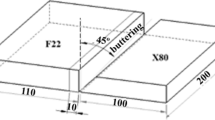Abstract
In this study, fillet welding processes were performed on high strength Miilux Protection 500 (MIL-A-46100) steel, which is used as armour material in defence industry, using GMAW method with austenitic ER307 and ferritic ER110S-G filler metals. The characterization of welded structure was carried out by performing elemental mapping processes as well as microstructural examination and microhardness tests. Results showed that hardness of weld metal was found to be 46% and 78% of the base metal hardness for austenic and ferritic filler metal, respectively. The fine-grained heat-affected zone was found to be the highest hardness while intercrital heat-affected zone was found to be lowest hardness through heat-affected zone. The smoother decrease was obtained in the softening zone with austenitic filler metal due to lower thermal conductivity. Consequently, the hardness values at a distance of 6 mm from the plate edge for both filler metals reached the hardness of base metal and both welded structures met the minimum requirements of the military standards.











Similar content being viewed by others
References
Neuvonen Y, Skriko T and Björk T, Eur J Mech A Solids 89 (2021).
Fageehi Y A, Saminathan R, Venugopal G, Valder J, Kumar H, Ravishankar K S, Mater Today 42 (2021) 343.
Mehara M, Goswami C, Kumar S R, Singh G, Wagdre M K, Mater Today (2021), (in press)
Nagireddi S, Majumdar B, Bonta S, and Diraviam A B, Trans Indian Inst Met 74 (2021) 2117.
Kuzmikova L, An investigation of the weldability of high hardness armor steel, PhD Thesis, University of Wollongong, Australia, (2013).
Magudeeswaran, Balasubramanian G V and Reddy G M, Mater Des 29 (2008) 1821.
Magudeeswaran, Balasubramanian G V and Reddy G M, Def Technol 10 (2014) 47.
Sabari, S S, Malarvizhi S, Balasubramanian V, and Reddy, M G, Def Technol 12 (2016) 324.
Alkemade, S J, The weld cracking susceptibility of high hardness armour steel, Defense Science and Technology Organization, Australia, 1–17, (1996)
Kumar N S, Balasubramanian V, Malarvizhi S, Rahman A H, and Balaguru V, Trans Indian Inst Met 74 (2021) 909.
Magudeeswaran G, Balasubramanian V and Reddy M G, (2014). Def Technol 10 (2014) 47.
Pramanick A K, Das H, Nandy S, and Pal T K, Trans Indian Inst Met 70 (2017) 1621.
Balalan Z, Sarsilmaz F, Ekinci O, Mater Test 62 (2020) 689.
Evci C, Işık H, Değirmenci E, Mater Test 56 (2014) 812.
Magudeeswaran G, Balasubramanian V and Reddy M G, Int J Hydrog Energy 33 (2008) 1897.
Bailey N, Coe F R, Gooch T G, Hart P H M, Jenkins N, Pargeter R J, Welding Steels Without Hydrogen Cracking (Second Edition), Woodhead Publishing, (2004), 46, ISBN 9781855730144
King J F, Sullivan M D, and Slaughte G M, Weld J 56 (1977) 354.
Saxena A, Kumaraswamy A, Reddy G M, Madhu V, Def Technol 14 (2018) 188.
Günen A, Bayar S, Karakaş M, J Eng Mater Technol 142 (2019) 1.
Savic B and Cabrilo A, Effect of heat Input on the ballistic performance of armor steel weldments, Materials 14 (2021), 3617.
Tandon V, Manish A. Thombre, Patil A P, Taiwade R V, Vashishtha H, Metallogr Microstruct Anal 9 (2020) 668.
Pandey C, Metall Mater Trans A 51 (2020) 2126.
Sirohi S, Pandey C, Goyal A., Int J Press Vessels Pipi 188 (2020) 104179.
Kumar S, Pandey C, Amit Goyal 185 (2020) 104128.
Maurya A K, Pandey C, Chhibber R, Int J Press Vessels Pip 192 (2021)104439.
Horii Y, Kazutoshi I, Shigeru O, Shuichi F, and Shuichi Y, Q J Jpn Weld Soc 13 (1995) 500.
Barbaro F J, Krauklis P, Easterling K E, Mater Sci Technol 5 (1989) 1057.
Abson D J, Sci Technol Weld Join 23 (2018) 635.
Danilchenko V E, Mazanko V F and Iakovlev V E, Nanoscale Res Lett 9 (2014) 322.
Xu J, Peng Y, Guo S, Zhou Q, Zhu J and Li X, J Mater Eng Perform 28 (2019) 6669.
Pandey C, Mahapatra MM, Kumar P, Thakre JG, Saini N, J Mater Process Technol 263 (2019) 241.
MIL-STD-1185, Department of Defense Manufacturing Process Standard: Welding, High Hardness Armor (31 Dec 1979) [Supersedes Mil-W-62162].
Acknowledgements
This study has been supported by Scientific and Technological Research Council of Turkey (TUBITAK) under the scope of "TUBITAK-1505" (University-Industry Cooperation Support Program) with the project number 5210019. Authors wish to thank Miilux OY Steel for the provisions of the steel plates under the technical and research cooperation programme between Miilux OY and Gedik Welding. Furthermore, authors wish to acknowledge the valuable contributions of Mr. Mert Basmacı for the preparations of the plates for welding.
Author information
Authors and Affiliations
Corresponding author
Additional information
Publisher's Note
Springer Nature remains neutral with regard to jurisdictional claims in published maps and institutional affiliations.
Rights and permissions
About this article
Cite this article
Gürol, U., Karahan, T., Erdöl, S. et al. Characterization of Armour Steel Welds Using Austenitic and Ferritic Filler Metals. Trans Indian Inst Met 75, 757–770 (2022). https://doi.org/10.1007/s12666-021-02464-7
Received:
Accepted:
Published:
Issue Date:
DOI: https://doi.org/10.1007/s12666-021-02464-7




